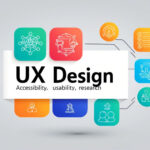Creating Empathy Maps that Actually Work

In today’s overcrowded digital world, if you’re designing without understanding your users, you’re designing in the dark.
Many digital products fail not because of poor visuals or broken features—but because they miss the emotional core of their users. They skip the foundational step of building empathy.
At UXGen Design Studio, we believe that understanding what your users think, feel, say, and do can transform your business outcomes. This is where empathy mapping comes in—not just as a UX exercise, but as a strategic tool for CRO, engagement, and digital growth.
If you’re struggling to make empathy maps that drive real decisions and ROI, this guide is for you. Let’s decode what makes empathy maps powerful—and actionable.
Understanding the Problem
Empathy maps are everywhere, yet few are effective.
-
7 out of 10 product teams use empathy maps in some form, but less than 35% use them to make actual product decisions.
-
Most maps end up as decorative artifacts rather than data-backed strategy tools.
-
60% of UX professionals admit their empathy maps are built on assumptions, not actual user research.
The result? Teams chase opinions, not insights. They build features users never needed, marketing campaigns that fall flat, and interfaces that don’t speak the users’ language.
Without authentic empathy, even the best interface fails to connect emotionally.
Solution & Insights
Creating empathy maps that actually work starts with shifting your mindset—from filling out a template to deeply observing users.
Here’s what the experts (and our 20+ years of field experience) say:
-
Base your empathy map on real research
Use user interviews, usability testing, and behavioral data. Avoid brainstorming what you think the user feels—ask them. -
Use the 4-core quadrant model—but go deeper
Go beyond “Think,” “Feel,” “Say,” “Do.” Add context: “Why do they feel this way?”, “What are their unmet needs?”, “Where are the friction points?” -
Involve cross-functional teams
Bring in marketing, customer success, product, and tech teams. Empathy should not be isolated to UX alone. -
Update regularly
Users evolve. So should your empathy maps. Review every quarter based on new data. -
Use AI for behavioral insight
Tools like heatmaps, user journey analytics, and AI-based sentiment analysis can reveal pain points hidden in plain sight.
Empathy is not fluff. It’s your product’s emotional intelligence. With the right process, it becomes a growth lever, not a UX formality.
Let UXGen Design Studio guide your UX process with data-backed insights and emotional intelligence.
Case Studies & Examples
Let’s walk through a real-world inspired example from UXGen Design Studio.
Client: EdTech SaaS Platform (hypothetical case)
The Problem:
The product had great content but high bounce rates and low course completion (just 23%).
What We Did:
-
Conducted 15 empathy interviews across 3 personas.
-
Discovered that learners felt overwhelmed on first login. They said they “didn’t know where to start.”
-
Mapped their emotions: Confusion > Frustration > Drop-off.
-
Refined onboarding using emotion-driven nudges and simplified the dashboard.
Results after 3 months:
-
Course completion jumped from 23% to 57%.
-
Activation rate increased by 34%.
-
Conversion to paid plan rose by 19%.
Empathy mapping uncovered a feeling—not a feature—that was blocking business growth.
Partner with UXGen Design Studio and create emotionally intelligent digital experiences that convert.
Actionable Takeaways
Here’s how to make empathy maps that actually inform strategy:
-
Start with user research, not assumptions
-
Map quotes, emotions, and behaviors—not just guesses
-
Look for patterns in user sentiment across multiple interviews
-
Use sticky notes (physically or digitally) to cluster emotional cues
-
Assign ownership—keep empathy mapping an active process
-
Link empathy findings to design decisions and KPIs
-
Validate the map against analytics or session recordings
-
Revisit and revise maps quarterly or post-feature launches
Step-by-Step Template (Simplified)
-
Define your primary user persona.
-
Conduct at least 5 user interviews.
-
Fill out Think/Feel/Say/Do with real quotes and behaviors.
-
Identify pain points, desires, and emotional states.
-
Connect these insights to product or content improvements.
Empathy mapping isn’t just for UX designers. It’s for every stakeholder who wants to grow with the user.
How UXGen Design Studio Can Help You
At UXGen Design Studio, we don’t treat empathy maps as a checkbox. We treat them as a blueprint for emotional alignment and business success.
Here’s how we help brands build empathy-driven growth:
-
User-Centered Workshops
We run real-time empathy workshops with your team, using behavioral data, interviews, and CRO insights. -
AI + Psychology-Driven Mapping
We merge qualitative emotions with quantitative signals (like heatmaps, funnel data) to design impactful experiences. -
Persona-Behavior Linking
We help create dynamic empathy maps that evolve with your user’s digital behavior—not static templates. -
Integration into UX Workflows
From discovery to design sprints, we ensure empathy informs every decision. -
Academy Support
Through UXGen Academy, we train teams and learners on mastering empathy tools for real product results.
When done right, empathy mapping boosts not just user satisfaction—but conversion, retention, and brand love.
Conclusion
Empathy is not just about understanding users—it’s about aligning your product with what truly matters to them.
When businesses invest in real empathy mapping:
-
Engagement improves.
-
Drop-offs reduce.
-
Revenue grows.
It’s time to move from guessing to genuinely knowing what users go through—and building experiences that care.
Want to turn emotional insight into real ROI?
Let’s build better experiences, together.
Explore how UXGen Design Studio and our group of companies—UXGen Technologies, UXGen Academy, and UXGen Marketing—can empower your digital journey with emotionally intelligent design, conversion strategy, and learning.
UXGen Technologies, UXGen Design Studio, UXGen Academy, and UXGen Marketing are ready to support your next phase of digital growth.
FAQs
Q: What’s the difference between empathy maps and personas?
A: Personas represent user types, while empathy maps explore emotional and behavioral dimensions of specific users. Both complement each other.
Q: How often should we update our empathy maps?
A: Ideally, quarterly. Especially after new feature releases or major user behavior shifts.
Q: Can small teams use empathy maps effectively?
A: Absolutely. Even one good interview can reveal insights. Tools like FigJam or Miro make it easier for small teams.
Q: Do empathy maps help with CRO?
A: Yes. By understanding emotional blocks, you can reduce friction and optimize journeys for higher conversion.
Q: Is empathy mapping only for UX professionals?
A: Not at all. Marketing, product, sales, and leadership can all benefit from it.

UX Audit: The Hidden Key to Better Conversions and Happier Users
Crafted to Convert: A Look Inside Purpose-Driven UX Design

About the Author
Subscribe for fresh
tips & top articles
UXGen Studio uses the data submitted through this form to send you relevant marketing insights, blog updates, and learning resources. To learn more, read our Privacy Policy.





